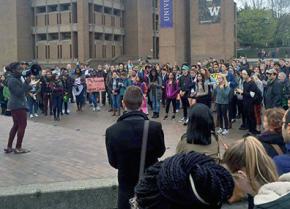Protests expose the truth about racism at UW
reports on a march against racism at the University of Washington.
WHAT DO you call a university where fewer than 2 percent of the faculty is Black? Whose police harass Black students? That excludes those with a criminal record from admission? Whose furniture comes from prison labor? That still pays hundreds of employees less than $15 per hour--a disproportionate number of them people of color--while paying its top 1,700 (mostly white) officials over $150,000 a year? Which cuts back on janitorial staff, also mostly immigrants and people of color, while speeding up and harassing those who are left?
According to the administration of the University of Washington (UW), you call it an institution committed to "equity." Students and staff at the UW aren't buying it--and are organizing to take on inequality at UW, most recently with a large march in campus on April 5.
Starting in the center of campus, more than 500 students marched to the Intellectual House, where the UW "Race and Equity Initiative" was holding a "dialogue" on micro-aggression.
Chanting "Whose lives matter? Black lives matter!" protesters took over the site of the dialogue and demanded that UW address its institutional bias. The rally and march were energetic and loud. Students of all races, national origins and programs united to say they would no longer tolerate racism at UW.

As Palca Shibale, a leader of the Black Lives Matter movement on campus put it, "How long do we have to stay in a suspended state of oppression until this university does something instead of just talking about it?"
THE STUGGLE against racism at UW is not new. In February 2015, more than 1,000 students and supporters marched through UW, stopping at various sites on campus. They presented a detailed list of demands to administrators, including increasing the enrollment of students of color and increasing the number of faculty of color. The response from the administration was discussion, but little action.
With great fanfare, new President Ana Mari Cauce announced the launch of the Race and Equity Initiative. According to the university:
The Race and Equity Initiative builds on the University of Washington's longstanding commitment to inclusion and social justice. The Initiative centers on creating an inclusive experience for students, faculty and staff, addresses institutional bias and racism, and engages our communities to help us work through our shared challenges for a world of good.
The philosophy behind the Initiative is that the solution to racism is better interpersonal relations at the individual level, and that there needs to be better cultural understanding. Though the Initiative mentions "addressing institutional bias," the real focus has been on the interpersonal.
There seems to be little recognition that the interpersonal issues are shaped by structures and institutions; that institutional racism is the main source of individual racist attitudes; or that institutions are by far the main source of racial harm in society. So far, the Initiative has set up "dialogues" on race, without touching on the question of institutional racism at UW.
The Black Lives Matter movement on campus recognizes this need for a focus on institutional racism, which prompted the April 5 march. As Shibale said, "There is something very sad to me about the Race and Equity Initiative. 'Recognizing' racism exists---that's how far we've gotten in 500 years."
Students and their supporters understand that more struggle will be needed. As Patricia Allen, a UW alumna put it, "Any safe place at this university was fought for by students like us doing things like this."
More protests are planned. This is the kind of " dialogue" that is really needed to confront racism at UW.


